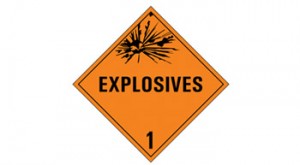 Print a Sign-In Sheet | Spanish Version Coming Soon
Print a Sign-In Sheet | Spanish Version Coming Soon
- Transporting
- Surface vehicles
- Vehicles should be in good operating condition; brakes, steering, lights, etc, in good condition. No other material or tools to be hauled in cargo space when explosives are transported. Explosives and detonators transported at same time shall be separated by 4” of hardwood or equivalent. Explosives should be transported promptly. When parked, turn off motor, set brakes, and block securely. Operate at safe speed. Post with adequate warning signs. Do not leave unattended.
- Transporting underground
- When transported underground, explosives and detonators shall be separated in special covered containers of nonconductive material with 4” hardwood partitions or equivalent. They should not be transported on the same trip with employees. A five minute interval shall be allowed before or after employees are transported. Locomotives shall operate at a safe speed and by experienced operator. No tools or flammable materials will be hauled in same car with explosives. No one except equipment operator is permitted to ride. If transported by belt, explosives shall be in permissible or original containers, with at least 18” clearance between belt and roof, with stop controls at suitable loading and unloading stations under competent supervision.
- Surface vehicles
- Storage
- Contact with other machinery or power cables
- Storage magazines shall be substantially constructed with no exposed metal on inside, located at least 25’ away from roadways and power wires, in well rock dusted and timbered area. Good housekeeping at all times. Magazine shall have 4” hardwood partition or equivalent if detonators are stored in same box. Oldest powder and detonators shall be used first. No more than forty-eight (48) hour supply shall be stored on section.
- Contact with other machinery or power cables
- In face areas, explosives shall be at least 50’ away, out of line of fire, kept in separate approved containers, 10’ apart in offsets in ribs, at least 15’ away from metal pipelines, conveyor lines, power lines, or rail lines. All unused explosives or detonators shall be returned to storage magazine at end of shift.
- Contact with other machinery or power cables
*Information taken from Job Safety Analysis Underground Manual, Office of Mine Safety and Licensing, Division of Safety Analysis, Training and Certification
KEMI does not assume liability for the content of information contained herein. Safety and health remain your responsibility. This information is to be used for informational purposes only and not intended to be exhaustive or a substitute for proper training, supervision or manufacturers’ instructions/recommendations. KEMI, by publication of this information, does not assume liability for damage or injury arising from reliance upon it. Compliance with this information is not a guarantee or warranty that you will be in conformity with any laws or regulations nor does it ensure the absolute safety of any person, place or object, including, but not limited to, you, your occupation, employees, customers or place of business.

